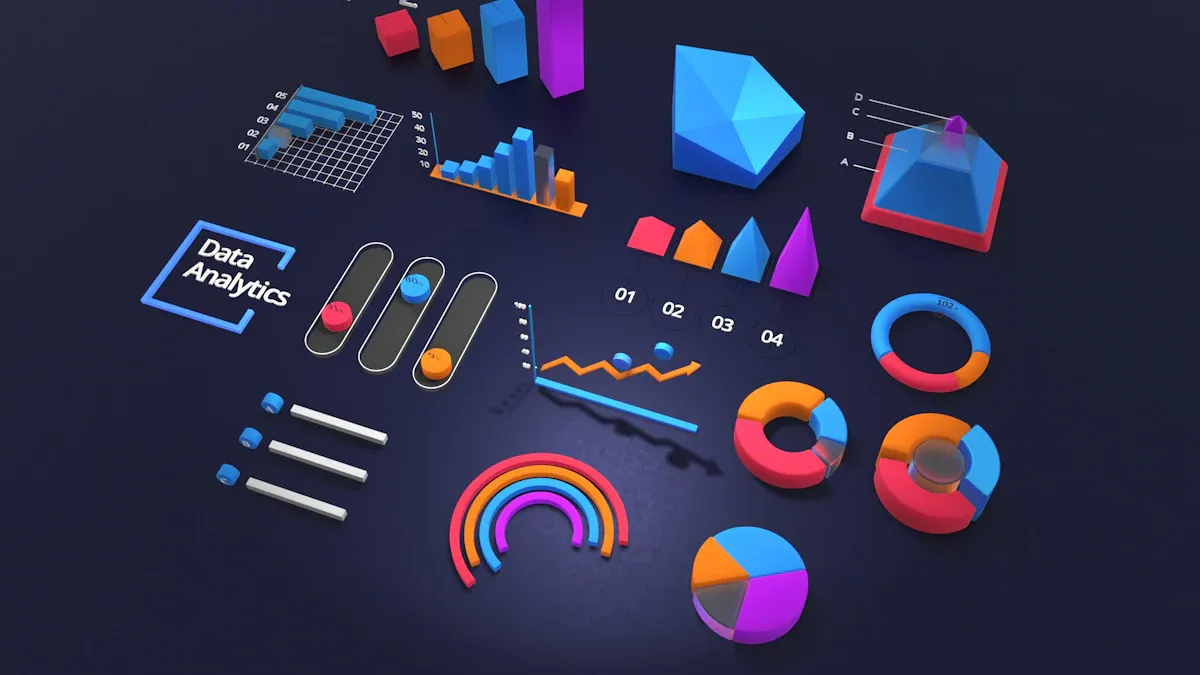3 Machine-Learning Pipelines That Boost Trend-Prediction Accuracy

Machine-learning pipelines transform how you predict trends by refining raw data into actionable insights. These systems identify complex patterns, improving forecasting accuracy over time. For example, hybrid sentiment analysis systems combining statistical methods with deep learning achieve up to 91% accuracy, outperforming simpler models by 17%. In financial forecasting, data-driven approaches like CNN-LSTM models significantly enhance prediction accuracy. By leveraging these pipelines, you can make faster, more informed decisions, gain deeper insights, and adapt to market changes with confidence.
Key Takeaways
Clean and organized data is key for good trend predictions. It helps with easy analysis and better forecasting.
Choosing and changing features improves how models work. Focus on the most important details to make results better and avoid mistakes.
Using many models together gives better predictions. This method reduces errors and makes forecasts more reliable.
Real-time data use gives quick insights. Tools like Apache Kafka handle data instantly, helping fast decisions.
Begin with one machine-learning pipeline and add more later. This step-by-step method makes it easier and gives better outcomes.
Data Preprocessing and Feature Engineering in Machine-Learning Pipelines

Clean and Structured Data for Accurate Predictions
Clean and structured data forms the foundation of accurate trend predictions. When your data is well-organized, it becomes easier to retrieve and analyze large datasets efficiently. This consistency ensures reliable trend detection and forecasting. For instance, clean data reduces the time spent on preparation, allowing you to focus on deeper analysis. It also supports advanced machine-learning models by providing high-quality inputs, which leads to actionable insights for strategic decision-making.
Benefit | Description |
|---|---|
Enables quick, efficient retrieval and use of large datasets. | |
Enhanced Consistency | Ensures reliability across data points for accurate trend detection and forecasting. |
Faster Analysis Turnarounds | Reduces time spent on data cleaning and preparation, allowing for deeper analytical work. |
Robust Predictive Analytics | Supports advanced statistical and machine learning models with high-quality inputs. |
Actionable Business Insights | Empowers companies to drive strategic decisions based on reliable and timely data. |
Feature Selection and Transformation Techniques
Feature selection and transformation are critical steps in machine-learning pipelines. These techniques help you identify the most relevant variables, improving model performance and reducing overfitting. Common methods include filter, wrapper, and embedded techniques. Each has unique advantages. For example, filter methods are fast and scalable, while wrapper methods offer higher accuracy by evaluating subsets of features. Embedded methods, on the other hand, integrate feature selection directly into the model training process.
Studies show that effective feature engineering significantly enhances predictive power. Data scientists often spend up to 80% of their time on this step because it improves model accuracy and flexibility. By focusing on the right features, you can ensure better data fitting and more reliable predictions.
Impact on Trend-Prediction Accuracy
Advanced data preprocessing methods have a measurable impact on trend-prediction accuracy. For example, applying transformations to data can improve the accuracy of decision tree models from 70% to 85%. These transformations also reduce performance gaps between forecasting methods, making simpler models more effective. Additionally, statistical methods like sMAPE consistently show improved accuracy when preprocessing techniques are applied.
Machine-learning pipelines benefit greatly from these enhancements. Clean data and well-engineered features allow you to extract meaningful patterns, leading to more precise forecasts. This accuracy empowers you to make informed decisions and stay ahead of market trends.
Ensemble Learning Models in Machine-Learning Pipelines
Combining Models for Enhanced Forecasting
Ensemble learning combines multiple models to improve forecasting accuracy. By leveraging the strengths of different algorithms, you can achieve better predictions than relying on a single model. For example, heterogeneous ensemble models often outperform homogeneous ones, with accuracy improvements ranging from 2.59% to 80.10%. This approach reduces prediction errors by minimizing correlations between base models, making your forecasts more robust and reliable.
Ensemble methods have proven effective across industries. In healthcare, combining CNN models for tumor detection increased accuracy to 95%, compared to 85-90% for individual models. Similarly, ensemble techniques reduced Quantitative Precipitation Forecasting errors by 35-40% over a five-year evaluation period. These results highlight the transformative potential of ensemble learning within machine-learning pipelines.
Bagging, Boosting, and Stacking Methods
Bagging, boosting, and stacking are three popular ensemble techniques that enhance trend prediction. Bagging, or bootstrap aggregating, creates multiple versions of a model by training on different subsets of data. This reduces overfitting and improves stability. Boosting focuses on correcting errors by sequentially training models, each learning from the mistakes of the previous one. Stacking combines predictions from multiple models using a meta-model, optimizing overall performance.
Case studies illustrate the benefits of these methods. Random forests and gradient boosting improved credit risk modeling accuracy by 5-10%. Stacking techniques in retail sales forecasting reduced inventory costs and increased customer satisfaction. In healthcare imaging, ensemble CNNs enhanced early lung cancer detection by 20%. These methods demonstrate their ability to address diverse challenges effectively.
Application | Method Used | Improvement/Outcome |
|---|---|---|
Credit Risk Modeling | Random Forests, Gradient Boosting | |
Healthcare Imaging | Ensemble CNNs | 20% improvement in early detection of lung cancer |
Retail Sales Forecasting | Stacking Techniques | Reduction in inventory costs and increased customer satisfaction scores |
Benefits for Trend Prediction
Ensemble learning offers several advantages for trend prediction. Combining models enhances accuracy, mitigates overfitting risks, and improves robustness. These methods excel in complex scenarios where single models struggle. For example, domain adaptive ensemble learning improved supervision signals in unsupervised settings, while ensemble approaches for forest fire detection reduced false alarm rates by 51.3%.
Machine-learning pipelines benefit greatly from ensemble strategies. They enable you to extract deeper insights, adapt to dynamic conditions, and make proactive decisions. Whether you’re forecasting sales, detecting anomalies, or managing risks, ensemble learning equips you with the tools to stay ahead of the curve.
Real-Time Data Integration in Machine-Learning Pipelines

Streaming Data for Immediate Insights
Real-time data integration allows you to process and analyze information as it is generated. This capability is essential for making quick, informed decisions in today’s fast-paced world. For example, edge computing minimizes the time needed to transmit critical data, enabling near-instantaneous insights. Automated anomaly detection systems can identify unusual patterns within milliseconds, helping you respond to challenges immediately. In industries like finance and healthcare, this approach ensures timely and accurate decision-making, which is crucial for success.
Recent advancements in data streaming have further enhanced trend prediction. Techniques like LSTM networks and RBDF^2M excel at detecting high-frequency market shifts. By integrating data from multiple sources, businesses can quickly adapt to emerging trends and seize new opportunities.
Tools for Real-Time Machine Learning
Several tools make real-time machine learning integration possible. A data ingestion layer gathers and processes information from various sources, ensuring no critical data is missed. Stream processing engines like Apache Kafka handle continuous data flows, performing real-time transformations. Machine-learning pipelines adapt to new data, refining predictions as conditions change. Finally, real-time analytics layers apply statistical techniques to streaming data, using NLP to extract sentiment and detect anomalies.
These tools have delivered measurable results. For instance, Starbucks increased sales by 20% during peak hours by using real-time analytics to monitor customer preferences. Walmart improved forecasting accuracy by 20%, optimizing stock levels and reducing waste. These examples highlight the transformative potential of real-time machine learning.
Overcoming Challenges in Real-Time Prediction
Integrating real-time data comes with challenges. Issues like data quality, privacy concerns, and fragmented sources can hinder progress. However, strategies like establishing data governance frameworks and fostering collaboration with stakeholders can address these problems. Advanced analytics and machine learning methodologies also help overcome biases and ensure accurate predictions. By adopting these approaches, you can unlock the full potential of real-time data integration.
Machine-learning pipelines play a vital role in improving trend-prediction accuracy. The three pipelines—data preprocessing and feature engineering, ensemble learning models, and real-time data integration—offer unique benefits. They help you refine data, combine model strengths, and process information instantly. By adopting these approaches, you can enhance forecasting, respond to market changes, and stay competitive.
To get started, explore tools like Apache Kafka, TensorFlow, or Scikit-learn. These frameworks simplify implementation and allow you to unlock the full potential of these pipelines.
Tip: Begin with one pipeline and expand as your needs grow. This step-by-step approach ensures smoother integration and better results.
FAQ
What is a machine-learning pipeline?
A machine-learning pipeline is a series of steps that automate data processing, model training, and prediction. It ensures consistency and efficiency in handling data, making it easier for you to generate accurate forecasts.
Why is data preprocessing important for trend prediction?
Data preprocessing removes errors, fills missing values, and organizes information. Clean data improves model performance and ensures reliable predictions. Without preprocessing, your results may be inaccurate or inconsistent.
How do ensemble learning models improve accuracy?
Ensemble learning combines multiple models to reduce errors and improve predictions. By leveraging the strengths of different algorithms, you can achieve more robust and reliable trend forecasts.
Can real-time data integration work with existing systems?
Yes, real-time data integration tools like Apache Kafka and TensorFlow adapt to existing systems. They process streaming data efficiently, allowing you to enhance predictions without overhauling your infrastructure.
What industries benefit most from these pipelines?
Industries like finance, healthcare, retail, and manufacturing benefit greatly. These pipelines help you forecast trends, detect anomalies, and make data-driven decisions in dynamic environments.
Tip: Start small by implementing one pipeline and expand as your needs grow. This approach ensures smoother integration and better results.
See Also
Effective Strategies for Retail Demand Forecasting Weekly
User Behavior Insights Using SQL and BI Without Complexity
Creating Funnel Reports to Analyze Purchase Drop-Offs
Why Need-Based Recommendations Outperform Standard Purchase Lists
Understanding Short-Term Demand Forecasting Techniques and Challenges
